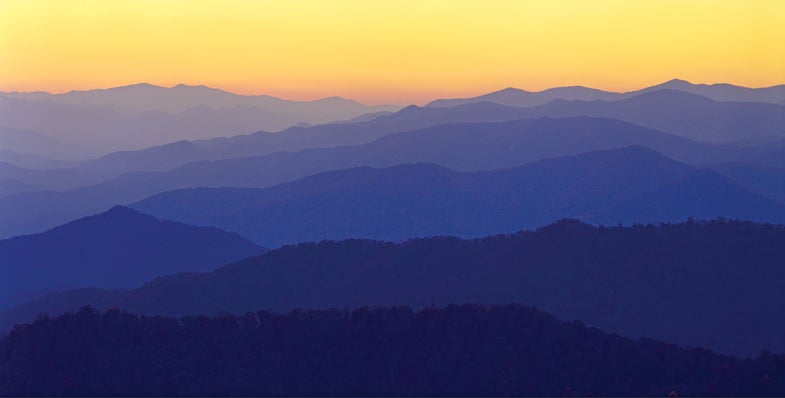How To: Photograph Patterns in Nature
Take the time to look around and study the intimate details, and you’ll see nature’s infinite variety of patterns

There is almost no end to possible pattern subjects in nature: a patch of wildflowers, textured or weathered wood, the details of a bird’s feathers, bubbles in ice, or shapes carved in a beach by a retreating tide. They can be found in the smallest of subjects or in the grandest sweep of the landscape. And patterns don’t exist only as static elements. Dynamic elements—such as passing clouds, or a flock of birds, or flowing water—can converge or interact in compelling patterns.
Finding Patterns
To discern photogenic patterns, look for two things: pleasing repetition of shapes, and dynamic spacing of elements in a scene. Shape repetition is an easy concept to understand—think of a grove of trees in a spring forest. Or it could be a series of stacked mountain ridges, such as the telephoto shot of the Blue Ridge seen at top right. Patterns can be parallel, as in a grove of trees, and can exhibit a certain symmetry. Diverging patterns, on the other hand, involve one or more shapes that diverge from the rest—imagine a grove of trees aligning vertically, except for one tree that is tilted at a diagonal angle. This diverging shape then becomes an immediate focal point.
Random patterns—such as lichen splotches on a rock—are more chaotic, and the trickiest to work with. But to a patient eye, subtle patterns can emerge from the randomness. Look to juxtapose complementary or contrasting colors, or to place a few repeating shapes prominently in the image frame. The spacing of elements is sometimes less intuitive. As a rule, avoid having repeating elements merge or otherwise touch each other.
Regular spacing of elements, however, is typically not the best approach. Instead, look for uneven spacing and grouping of elements—a group of four closely spaced trees on one side of the image, counterpointed by one lone tree on the other side. Bunching or merging repeating shapes, though, can sometimes help one element flow into the next, leading the eye throughout the scene.
Patterns can also be produced by the interplay of color and light. A few fallen red autumn leaves may break up the pattern of crisscrossing green ferns. Reflections of different colors in moving water can create dynamic abstracts. Transitions between sunlit and shadow areas also create layers and shapes.
Pattern compositions can be very effective when working with wildlife, as well. It requires patience to wait for a group of animals to align in a pleasing pattern, but when the opportunity arises, seize the moment to create dynamic and different wildlife images.
You can render moving animals as abstract patterns by panning along at a slow shutter speed, as I did in the opening photo. And blurring and panning need not be limited to moving subjects. Experiment photographing a stand of trees, panning the camera upward during an exposure of 1/2 sec or so.
How to Shoot Patterns
Although any lens can be used for pattern photos, telephoto zooms and macro lenses will likely be your workhorses. Short to medium telephoto zooms (in the 70–400mm range) in particular are great for closing in on the details of nature.
When working with pattern images, depth-of-field is often an issue, as you may be working at a sharp angle from the plane of focus of your subject. Use small apertures (such as f/16, f/22, or smaller) as necessary to ensure sharp focus throughout the image frame. Also, use live view and your depth-of-field preview to help achieve critical focus and optimal aperture. A sturdy tripod is often necessary to ensure sharpness.
Macro lenses can be especially useful when photographing small details, but you can also rely on inexpensive extension tubes or front-mounting close-up filters.
The lessons learned when creating intimate pattern photos can be applied to other types of compositions, including sweeping grand landscapes. Pattern photos require a patient approach, and a keen eye for the subtleties of our natural world. The rewards, however, are definitely worth the effort.
Ian Plant is a professional nature photographer, writer, and instructor. To see more of his images, read his daily photoblog, or learn more about his photo workshops and instructional e-books, visit IanPlant.com.